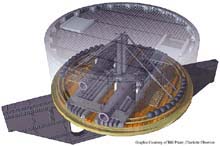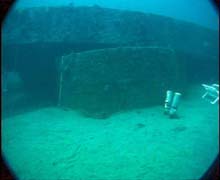
The Monitor’s turret, pictured here, houses two Dahlgren cannons inside. Click image for a larger view..

The partners in Monitor Expedition 2002 hope to recover the Monitor’s turret, shown here, this summer. Click image for a larger view.

The derrick barge Wotan lifting the Monitor’s engine above the ocean surface during the 2001 Expedition. The same barge will be used for Monitor Expedition 2002. Click image for a larger view.
Mission Plan
John Broadwater
Sanctuary Manager
Monitor National Marine Sanctuary
Monitor Expedition 2002 is our most complex mission yet, eclipsing even last year’s six-week engine recovery expedition. This year we hope to recover the Monitor’s famous 130-ton armored gun turret, including its two 8-ton Dahlgren cannons.
This year’s expedition is a continuation of a long-term project. Several years ago, NOAA determined that the collapse of the Monitor’s hull was imminent and would result in the loss of much of the ship’s structure and historic contents. To head off this threat, NOAA and the U.S. Navy conducted missions to the sanctuary in 1993, 1995, 1998, 1999, 2000 and 2001 to survey the wreck's condition, stabilize the hull, and recover significant components and artifacts, all in accordance with NOAA's 1998 comprehensive preservation plan for the Monitor
The Navy conducted additional survey and site preparation work in 1999. In 2000, they recovered the skeg and the remaining section of the propeller >shaft. The Navy also placed a 90-ton Engine Recovery Structure over the engine room to prepare for recovery of the Monitor's steam engine.
During the 2001 expedition, the engine was successfully rigged, recovered and transported to The Mariners' Museum in Newport News, VA, for conservation and exhibition. NOAA's scientific dive teams have conducted additional site investigations each year, in partnership with several other organizations and agencies.
2002 Objectives
The major objectives for this year are to remove a section of the Monitor's armor belt and hull that lie atop the turret, to partially excavate the turret, and to rig and recover the turret and all its contents.
Monitor Expedition 2002 began on May 15, 2002, when the first trucks left the Naval Amphibious Base in Little Creek, VA. They transported equipment that was loaded on the support barge in Houma, LA. The Derrick Barge (DB) Wotan, which also supported last year’s expedition, is fitted out especially for Monitor Expedition 2002. DB Wotan is equipped with a 500-ton derrick crane, accommodations for 116 personnel, and equipment to support two simultaneous dive operations as well as robotic dive operations. The barge departed Houma on June 7, 2002, and should arrive at the Monitor National Marine Sanctuary around June 26.
The expedition team will spend 45 days on site, plus approximately four weeks conducting mobilization procedures and three weeks of demobilization procedures. Two weeks of transit time each way between Louisiana and the sanctuary also is required. On-site activities are expected to occur between June 17 and July 31. Additionally, a NOAA scientific dive team will conduct survey tasks on site between July 23 and August 17. Therefore, the NOAA expedition may overlap recovery operations by a week or more, offering the opportunity for NOAA divers to assist Navy divers. NOAA divers also may be able to record parts of the Navy expedition on videotape.
If all goes well, we hope to transport the turret to The Mariners’ Museum in early August. At the museum, it will undergo an electrochemical conservation treatment. The Museum plans to allow visitors to watch the conservation process, which could take five to ten years to complete.
Sign up for the Ocean Explorer E-mail Update List.

































